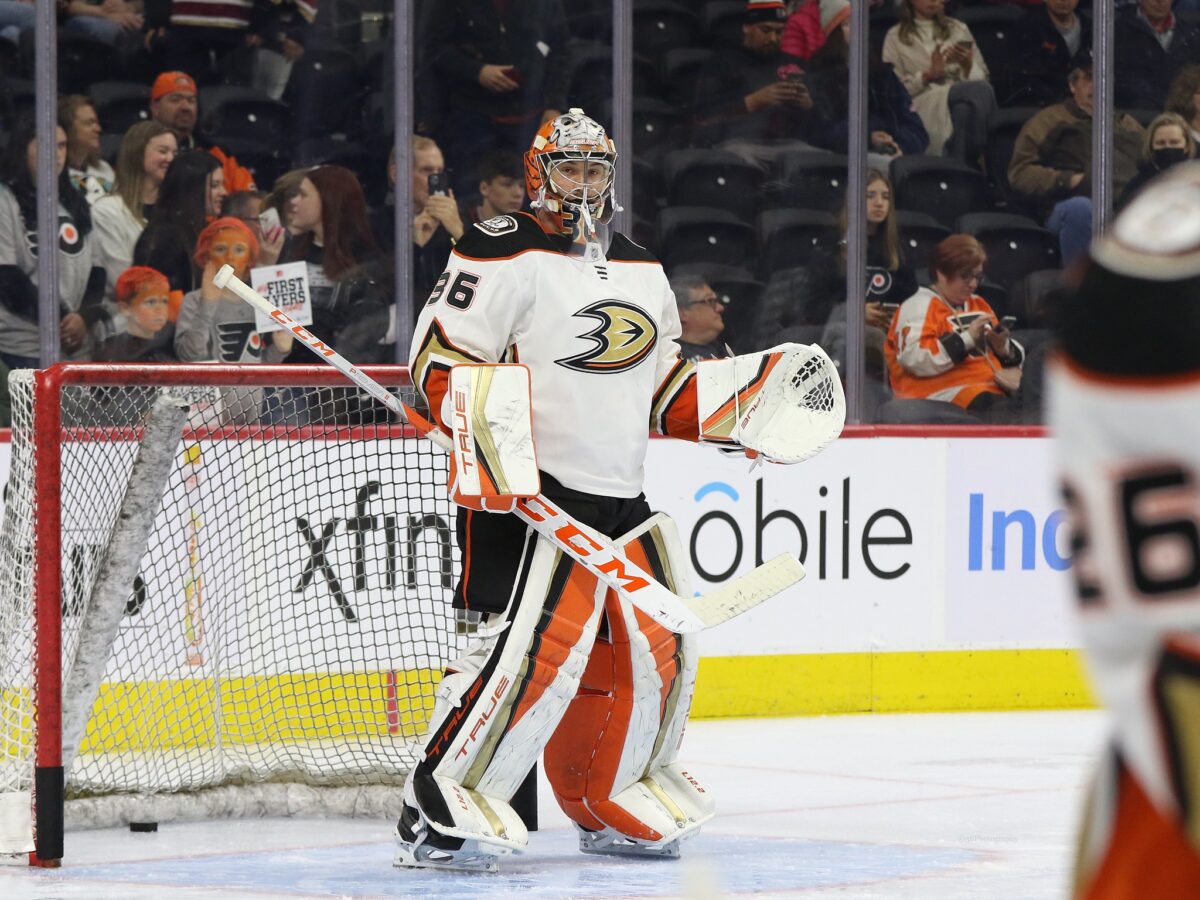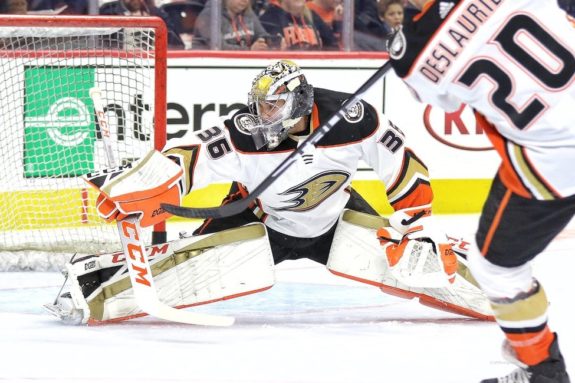After failing to make the postseason for the fourth straight season, the Anaheim Ducks are officially in offseason mode. With the 2021-22 season in the rearview mirror, we can look back at some of the individual seasons that Ducks’ players had and how they fit moving forward.

John Gibson has been the Ducks’ workhorse goaltender for the last six seasons. Since the 2016 trade of Freddie Andersen, Gibson has played no fewer than 52 games in a full 82-game season. He was stellar in his first few seasons as the starter, but the last few seasons have set a troubling trend. After an impressive start to the 2021-22 campaign, Gibson’s numbers began to crater in the second half of the year, coinciding with the Ducks’ late-season fall in the standings.
Gibson’s Early Play Warrants All-Star Nod
After several difficult seasons, Gibson got off to a strong start. From Oct. 31 to Nov.16, he went on a personal seven-game winning streak as the Ducks catapulted up the Pacific Division standings. By Jan. 12, his counting stats were among the highest in the league, including fifth in minutes and third in saves. These figures were enough for him to be named the Pacific Division All-Star team’s goaltender, along with Thatcher Demko of the Vancouver Canucks.
But underneath the lofty numbers were some causes for concern. As he was announced to the All-Star Game, Gibson’s 6.28 goals saved above average (GSAA) was 12th in all situations, bolstered by a league-leading 9.24 GSAA on the penalty kill, according to Natural Stat Trick. In 5-on-5 situations, it was a different story, as his minus-3.94 GSAA ranked 25th out of 30 qualified goaltenders.
Gibson’s Second Half Backslide Dooms Ducks
After entering the All-Star Break in second place in the Pacific Division, the Ducks returned from the break to begin a downward spiral that would lead to them finishing the season in seventh place. In Gibson’s 23 games after the All-Star Break, he posted league-low numbers with a .876% save percentage and minus-19.94 GSAA. While his 5-on-5 numbers continued to be near the bottom of the league, the elite penalty-killing numbers from the first half of the season disappeared, posting a minus-2.82 GSAA while shorthanded. Gibson was credited with only three wins after the All-Star Break.

The second half of the season was largely forgettable for Gibson, but he still had his share of highlights. In an April 12 game against the Florida Panthers, Gibson put on a show, stopping 52 out of 55 shots in an overtime loss. The loss pushed his personal winless streak to 13 games, but head coach Dallas Eakins was quick to absolve his goaltender.
“We can’t ask any more of him…There’s been some focus on the fact that he hasn’t won a game. We have not won a game,” explained Eakins after the loss to the Panthers (from ‘Ducks’ Dallas Eakins on goalie John Gibson: This isn’t easy on him’, Orange County Register, April 17, 2022).
Gibson’s Future in Anaheim is Unclear
Gibson and the Ducks agreed to an eight-year extension on his contract in 2018, locking him down until the end of the 2027 season. Anaheim has failed to make the playoffs in each of the four seasons since the extension. But In fairness to him, his extension came shortly before the roster bottomed out and needed re-tooling. Despite several rough seasons, he’s shown enough to prove he can be an elite goaltender. A high workload in terms of both games played and minutes spent behind a rebuilding defense can have a negative effect, and he’s shown a tendency to play better at the beginning of a season before cooling off.
Related: Anaheim Ducks’ 5 Worst Trades in Franchise History
With goaltending prospects like Lukas Dostal, Olle Eriksson Ek, and the recently acquired Calle Clang, there’s a good chance the Ducks will have a capable NHL goaltender available before Gibson’s contract runs its course and whose age will be better suited for the Ducks’ eventual competitive window. With current backup goaltender Anthony Stolarz putting up an impressive season in unjustifiably limited duty, the Ducks have plenty of options in net moving forward.
While Gibson is the best option today, he’s also the best option for teams who believe they are only a goaltender away from competing for a Stanley Cup. His contract includes a 10-team no-trade list, which could certainly complicate a trade for a goaltender with a lot of term remaining on his contract. General manager Pat Verbeek proved he was willing to make the necessary moves to set the Ducks up for long-term success with a series of moves at the trade deadline. Gibson can be a capable goaltender for a legitimate contender. Whether that opportunity comes in Anaheim remains uncertain.
